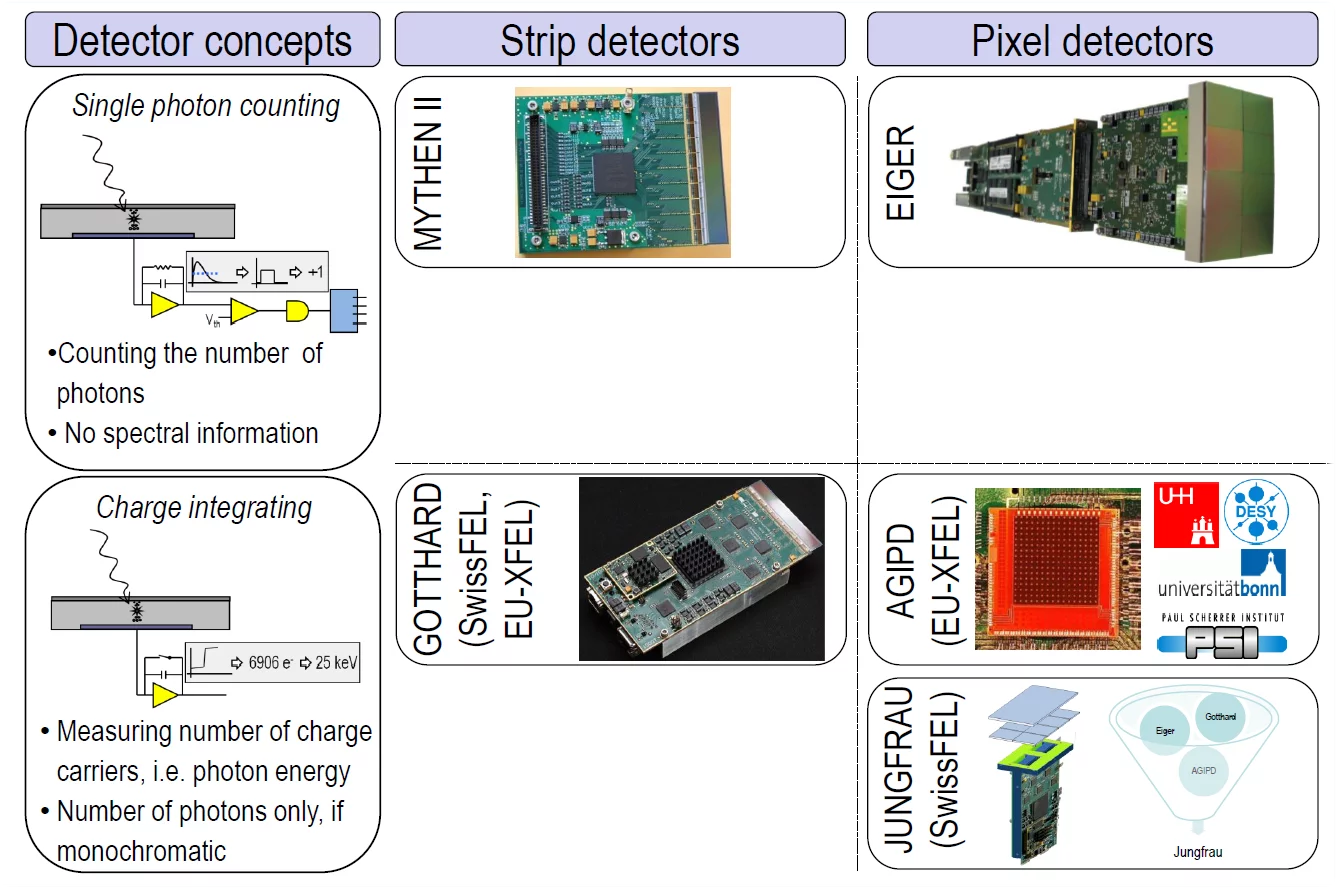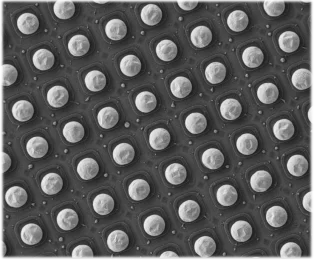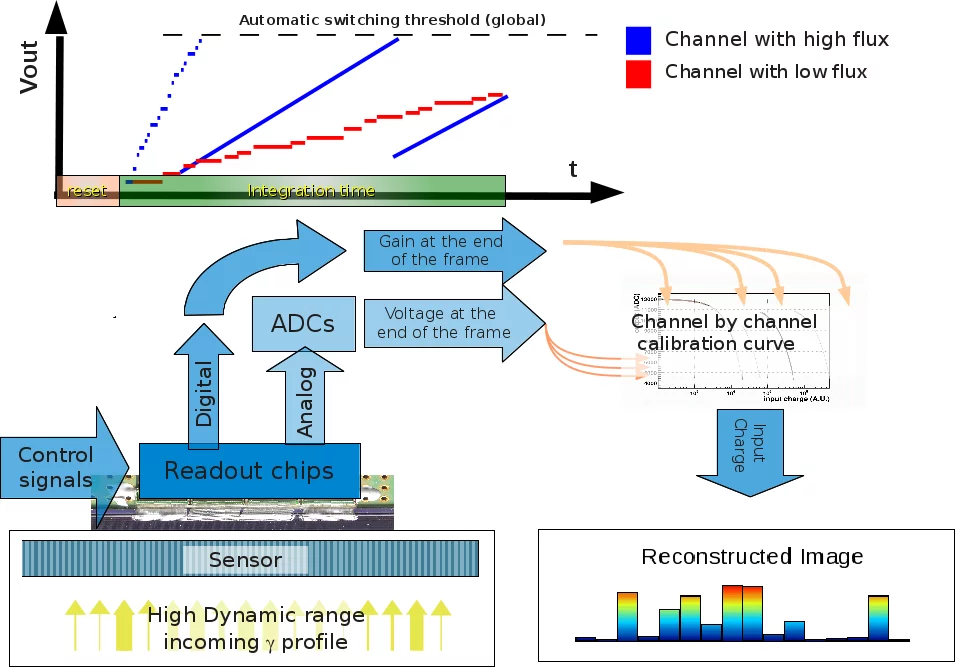
Projects
The Detectors Group at the PSI Center for Photon Science develops hybrid detectors specifically for synchrotron radiation applications. These detectors are designed to provide high-quality data while ensuring reliability for daily operation at the beamlines. Both 1D strip detectors and 2D pixel detectors are developed, incorporating in-house or collaborative single-photon counting and charge-integrating readout ASICs, detailed below.
In keeping with tradition, all our detectors are named after Swiss mountains: MYTHEN (near Schwyz), GOTTHARD (connecting northern and southern Switzerland), and EIGER, MÖNCH, and JUNGFRAU (in the Bernese Oberland). The AGIPD detector, being part of a larger collaborative effort, is an exception to this naming convention.
A brief overview of the key properties of these detectors is provided below.
Hybrid detectors
Hybrid detectors consist of two distinct components: a sensor that absorbs radiation and frontend electronics that convert the resulting charge into a digitizable signal. This separation allows for independent optimization of each part based on the specific application. The technology used to interconnect the sensor and readout electronics is equally critical. The Detectors Group specializes in producing wire- and bump-bonded detectors with high yield across large pixel arrays.
Our detectors are primarily optimized for silicon sensors with a thickness of 0.3 to 1 mm, providing over 50% absorption efficiency for X-rays in the 6–15 keV range, typical of most SLS beamlines. By connecting the readout electronics to sensors made from alternative materials, we can further tailor detector performance for specialized applications, as detailed in the research section.
Single-photon counting readout
The single-photon counting detectors developed by the Detectors Group include MYTHEN (1D) and EIGER (2D).These detectors are highly sensitive to individual photons, with the only inherent fluctuation in count numbers arising from the Poisson-like statistics of X-ray quanta. However, the digitized signal lacks energy information, as each photon exceeding the set energy threshold is counted as one bit. Therefore, careful selection of the comparator threshold is crucial to ensure all relevant photons are detected while minimizing electronic noise and suppressing background fluorescence from the sample.
The minimum detectable photon energy is constrained by the electronic noise, while the dynamic range is determined by the bit depth of the counters. Since single-photon counting detectors are free from readout noise, their dynamic range can be further extended by summing multiple frames without increasing statistical uncertainties. This exceptional dynamic range, combined with the ability to detect single photons without saturation, makes these detectors ideal for experiments requiring high sensitivity, such as those involving thin or weakly scattering samples.
At high photon fluxes, photon-counting systems can experience non-linearity due to signal pile-up when multiple photons are absorbed in quick succession by the same strip or pixel. While this is not problematic for most experiments, certain applications, such as single-crystal diffraction, may be affected by this limitation. Moreover, single-photon counting techniques are not suited for use with X-ray Free Electron Lasers (XFELs), as the intense pulse from a single bunch would cause the detector channels to register only one photon, regardless of the actual photon flux. To address this, charge-integrating detectors are being developed for use in such high-intensity environments.
Charge-integrating readout
The charge-integrating detectors developed by the Detectors Group include GOTTHARD (1D), as well as AGIPD, JUNGFRAU and MÖNCH (2D). These detectors work by continuously integrating the charge collected from the sensor, enabling them to detect photons without a minimum energy threshold, as long as the photons are absorbed by the sensor and single-photon resolution is not required. However, the dynamic range of the frontend electronics—the ratio between the signal that causes saturation and the electronic noise—can be a limiting factor.
To address this, the detectors developed by the group incorporate the principle of automatic gain switching. This approach allows the system to dynamically adjust its sensitivity based on the incoming signal intensity, optimizing the detector’s performance by maintaining a wide dynamic range and reducing the risk of saturation even at high photon fluxes.
Automatic gain switching
Automatic gain switching is a method that expands the dynamic range of a charge-integrating detector while maintaining the electronic noise well below the Poisson limit set by the number of photons. This enables the detector to achieve single-photon resolution without reaching saturation, even at flux levels up to 10⁴ photons per channel.
At the start of a measurement, the amplifier is reset and the gain is set to its highest level. Once the reset is released, the charge begins integrating on the feedback capacitor. If the output signal from the amplifier reaches a predefined threshold, additional capacitors are switched in, which lowers the output voltage and effectively extends the dynamic range. At the end of the measurement, both the analog signal and the digital gain information are read out. The number of photons absorbed in each channel is then reconstructed using a channel-specific calibration curve. This switching mechanism works for both continuous charge input, such as from synchrotron radiation, and instantaneous charge releases from XFEL pulses.
In theory, a gain-switching detector with an infinite frame rate would be ideal, offering single-photon resolution, a broad dynamic range, and even energy resolution at low rates. However, such a system generates an enormous amount of data, necessitating advanced analysis and compression before storage can occur.




